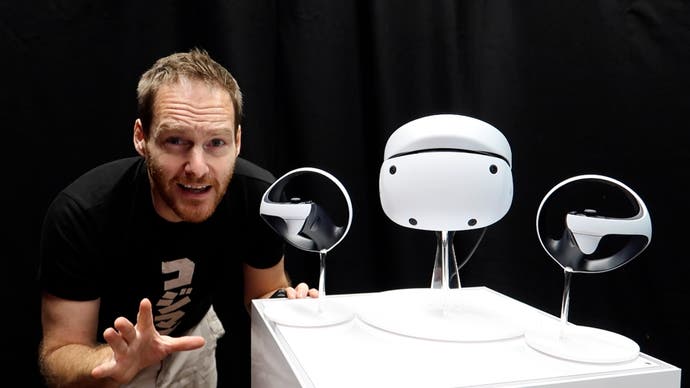PlayStation VR2 is about to breathe new life into virtual reality gaming
First impressions from Sony's impressive new hardware.
Wow. Wow, wow, wow. That's the word that keeps springing to mind when I try to sum up my time with PlayStation VR2. As a fervent fan of VR for many years now, it's safe to say that my first hands-on experience with Sony's upcoming headset wowed my VR-loving socks off. This sleek and stylish unit was all I could have wanted for an upgraded PSVR headset and much, much more.
In terms of technological and visual quality, this feels like one of the more memorable generational console leaps. Experiencing the difference in visuals between the PSVR1 and the PSVR2 brought back memories of graduating to the sparkly, sharp, high-definition games of a PS3 after spending years playing games on the PS2 in standard definition.
Even the visuals afforded by my beefy PC VR rig seemed to pale in comparison to some of the wonders I witnessed whilst inside the PSVR2 and you can watch me breathlessly gush over it in the video below. There's around 40 minutes of PSVR2 information and impressions in there, including detailed close-ups of the kit, descriptions on how to calibrate the headset for eye-tracking and room-scale VR and beautiful 4K footage of the four game demos I played; Horizon Call of the Mountain, Resident Evil Village, The Walking Dead: Saints & Sinners - Chapter 2: Retribution and Star Wars: Tales from the Galaxy's Edge - Enhanced Edition
PlayStation VR 2
So what exactly did I find so great about the PlayStation VR 2? What, in my opinion, elevates it above the majority of consumer VR units on the market at the moment. Well, it's honestly hard to know where to start as I was given such a generous amount of time with the PSVR2 that there's a lot to talk about.
First up, and before I get into all the technical gubbins, there's the comfort factor. The PSVR2 is much lighter than I expected and it's really comfy as well. Once on your head, it's pretty easy to forget it's even there, especially as there's hardly any light leakage from outside the headset.
One of the biggest criticisms I've seen about the headset previously was the fact that it wasn't standalone and that you had to use a cable to connect the unit to the PS5. Thankfully, this cable is a decent length, coming in at around 4.5 meters, and again that cable feels a lot lighter than both the PSVR1 and Rift S cables (the only ones I'm familiar with). This meant that I didn't get tangled up during the games that had a lot of physical turning in them, and it didn't feel like the cable was dragging my headset down, which is a problem I've had in the past with other set-ups.
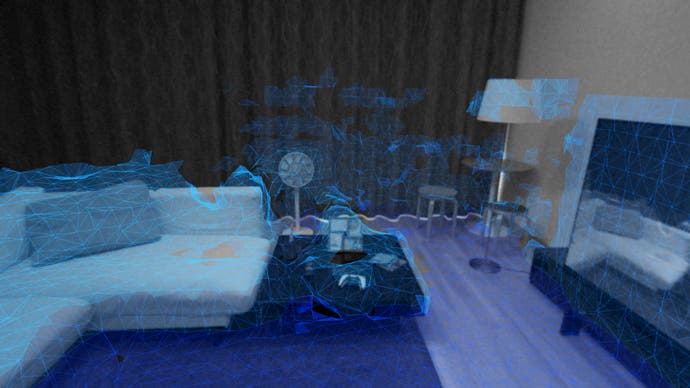
In terms of visuals, the PSVR2 supports 4K HDR gameplay, with a 110-degree field of view that easily fills your vision. The twin OLED display lenses also give users a resolution of 2000×2040 per eye with smooth frame rates of between 90/120Hz depending on the game. In layman's terms, this means everything looks incredibly crisp and detailed, even at a distance, with lifelike colouring and lighting creating easily believable and immersive worlds. Seriously, to go from the muddy, Vaseline-on-your-lenses visuals of the PSVR1 to virtual worlds with visuals this clean and sharp will have you picking up your real-life jaw from the virtual floor.
The power of the visuals in the PSVR2 are enhanced even more thanks to the headset's eye tracking feature. Eye tracking detects the motion of the user's eyes and this data can be used in a variety of different ways. This can include simple, but highly immersive things, like having game characters look you directly in the eyes when they're speaking to you, through to a really impressive technique called foveated rendering. Again in layman's terms, because I'm no Digital Foundry, this basically means that games that support this feature can tell exactly where you're looking and will render the graphics in much higher detail in that space.
Also new to the PSVR2 headset was Sense Technology which, to tech-noobs like me, is basically headset rumble. It's an optional feature that can be easily switched off in the PSVR2's menus, but it's one that adds an extra layer of immersion to an experience. You want to feel like a Stormbird has just swooped down within a metre of your head? I can tell you right now that with the Sense Technology, this is absolutely possible. I feel like this feature might be a bit too much of a sensory overload for new users, and it may be a bit intrusive for veterans at times, but overall I enjoyed the extra sensation.

Controller-wise, the new Sense Controllers are leagues ahead of the PSVR1's fun but fiddly Move Controllers. Gone are the days of controller drift or dodgy tracking because, thanks to the PSVR2's inside-out tracking and the finger touch detection on the controllers themselves, any movements made in real-life are accurately tracked in VR. This, combined with the twin thumbsticks, removes pretty much all of the frustrations that came from using the Move controllers to play more complex, first-person games like, say, The Walking Dead: Saints and Sinners. The Sense Controllers made movement in VR feel effortless and because of this it was even easier to forget the outside world and become immersed in the demos I was playing.
Oh, and did I mention that the controllers are really comfy to hold too? Because they are! They fit the hand really nicely and the button spacing is such that my fingers were always by the right button at the right time. I never once experienced an immersion breaking struggle with the controls, which is something I definitely can't say for the Move.
There's honestly so much to love about the PSVR2 and hardly anything I can think of to criticise at this point in terms of form and functionality. As I've already mention it blows the PSVR1 out of the water in every aspect, but with resolutions per-eye coming in at almost double that of my Rift S, the difference in visuals between the way I've been experiencing VR on a PC and what the PSVR2 offers was, quite frankly, staggering.
But how does this all impact the most important thing about VR - the games? Let's find out.
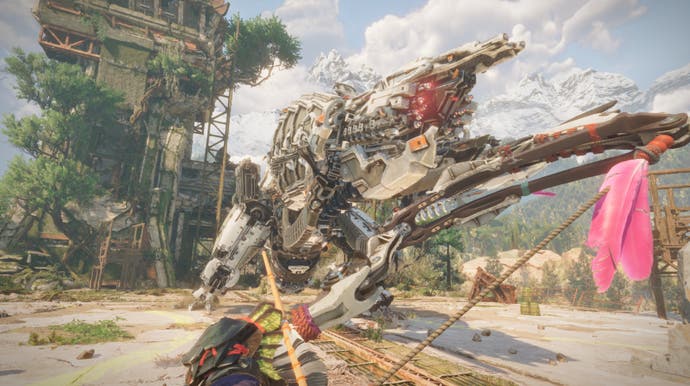
Horizon Call of the Mountain
The first demo I played was probably the most technically impressive as it was the only first-party game on show. This meant it utilised all of the PSVR 2’s new tricks so it was an excellent introduction to the tech.
Horizon Call of the Mountain starts with a leisurely boat ride down a tight river, surrounded by lush, dense vegetation. At this point it’s merely a stationary experience, akin to something you’d find in a theme park attraction, but here you don’t need to keep your arms inside the ride at all times. Being able to lean over the side of the boat and splash away at the clear blue-green waters that we were floating on was a nice touch that helped ground me in the experience, but it wasn’t enough to distract me from the beauty of the scenery we were sailing through.
The intense colours and the incredible level of detail to the forest was intoxicating and at times, I struggled to take it all in - there’s so much I wanted to look at and I only have one pair of eyes! Considering I normally hate it when VR games lock you in one position in order to feed you exposition, Call of the Mountain did an amazing job of keeping me entertained with a variety of visual spectacles. Sailing gently between the legs of a Tallneck was one such moment and it left me slack jawed in awe, but the moment I first felt the PSVR2’s headset feedback as a Stormbird swooped down over my head is one I’ll remember for ages. I’d forgotten all about this feature and so I was equally delighted and surprised when I physically felt that massive presence pass me by. A true ‘wow’ moment indeed.
Once off the boat a bit more freedom is given to the player, but you’re still on quite a linear path, albeit one that involves lots and lots of climbing. I was actually quite surprised at how vertical this little section of the gameplay was, but hanging from great heights also allowed my eyes to really soak up the detail of the world around me. Because Horizon supports eye tracking and foveated rendering, every inch of the world that I scanned looked super sharp and the detail was high on even the furthest objects.
Movement-wise, Call of the Mountain gives you a couple of options. You can play seated or standing and also you can choose between gesture-based movement or standard thumbstick controls. I opted for gesture-based to try out something different and while I don’t think it’s something I’d choose for the final game, I was pleasantly surprised by how accurate and easy this method was - especially when compared to similar schemes on the PSVR1 with Move Controllers.
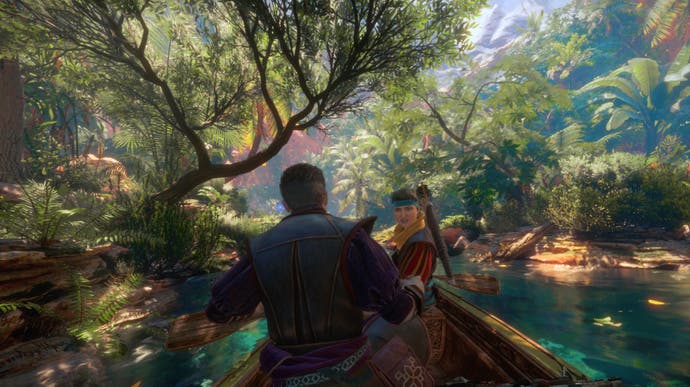
Combat was also very fun and the bow that I used throughout the demo worked perfectly. I was able to fire off many an arrow without any of that janky fumbling you might have experienced when using Move controllers to simulate archery in the past. I do suspect that the core combat might be a little too on rails for some veteran helmet-heads though as, whenever I was facing off against a Machine proper, I was locked onto a circular path and had to dodge and circle-strafe along this track in order to defeat the enemy.
It was a design choice that struck me as slightly odd at first, but it made sense when Guerilla’s Studio Director Jan-Bart van Beek told me, "The core of the combat is very much about long ranged weapons so of course the bow is a key weapon. Beyond that we have quite a lot of other ranged weapons. What we don’t have is melee combat as it doesn’t really fit with what we’re doing here. It feels like a Horizon game though, when you’re shooting your arrows at those weak points and taking the parts off." Firesprite’s Alex Barnes who is Call of the Mountain’s Game Director explained more about the thought process behind it. “As you can see with the new perspective in VR, just being under a Thunderjaw and just being like ‘Holy crap, this is huge and it’s bearing down on me and it’s charging up its lasers and firing its discs’, is an overwhelming feeling that you get when you first encounter a Thunderjaw in Zero Dawn. That’s something we were really keen to capture and put into VR."
It wasn’t all dodging gigantic dino tails though, there was also a quiet village mid-demo that was littered with interactive objects. Tambourines, maracas, a lock and key and also an area where I was able to indulge in a bit of cave painting were all things that allowed me to fiddle around and slowly get to grips with the new Sense Controllers.
While Sony wasn’t able to confirm whether or not Call of the Mountain would be a launch title for the PSVR2, it makes sense that it should be. Call of the Mountain does an incredible job of showcasing the features of this new headset and it delivers spectacles that will make VR veterans giggle with joy, whilst at the same time giving newcomers to VR a gentle learning curve that’ll ease them into a brand new world of virtual possibilities.
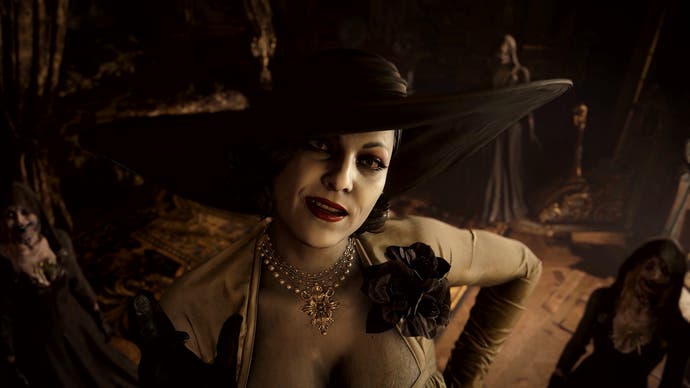
Resident Evil Village
Resident Evil Village’s PSVR2 port was officially announced during Sony’s State of Play in June but it’s an experience I was able to get an early look at thanks to a magnificent flatscreen to VR mod from a talented modder named Praydog, who even threw motion controls and a full player avatar into the mix.
It wasn’t the perfect mod, though, and it had plenty of areas for improvement, including a lack of physical reloads and some very wonky crouch animations. The mod did however let you experience both the thrills of Lady D and the chills of the Beneviento mansion in full 6DOF VR at a time when the idea of a PSVR2 port was simply wishful thinking.
So how does the official release compare to the fan-made mod? Well quite simply, and obviously, it’s way more polished experience and it's gorgeous to look at through the lenses of the PSVR2. The core gameplay remains unchanged from the original game of course, but unlike Capcom’s Resident Evil 7 PSVR port, in Village you have full motion controls with the twin Sense controllers, rather than having to rely on a standard Dualshock controller. This allows you to hold weapons in either hand, which is great for left-handers, and it also means you can easily dual wield a knife and a pistol at the same time. Manual reloading is also present in the offical version as well as is the ability to pick up or physically interact with things like collectables and drawers.
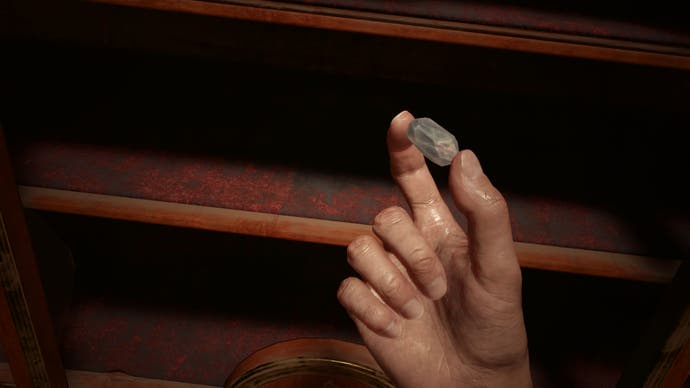
Not only that, but if you check out my video, you’ll also get a quick glimpse of some of the cool tricks you can do with those weapons thanks to the motion controls and the in-game physics. I discovered that it was possible to do things like juggle the pistol and knife, balance your knife on your gun like that tiny dagger on Thanos' finger or even throw ammo magazines up into the air and catch them with the ammo slot in the pistol’s grip. These tricks are not that easy to pull off, mind, but when you manage it, it feels very cool indeed.
In one aspect however, Praydog's mod is superior, and that's Village's lack of a full body model for Ethan Winters. Instead, just like in Resident Evil 7 VR, we're limited to floating hands only, which isn't exactly a deal breaker but it is a bit of an immersion breaker at times. No body for Ethan should sort out those wonky crouch animations though to be fair.
Playing through Resident Evil 7’s PSVR port is still one of my favourite gaming memories of all time and with Village on PSVR2 you’re getting something that improves on that magnificent experience in almost every way. I do wonder how Capcom will approach the prologue chapter where Ethan is holding baby Rose though. Surely not like this?...
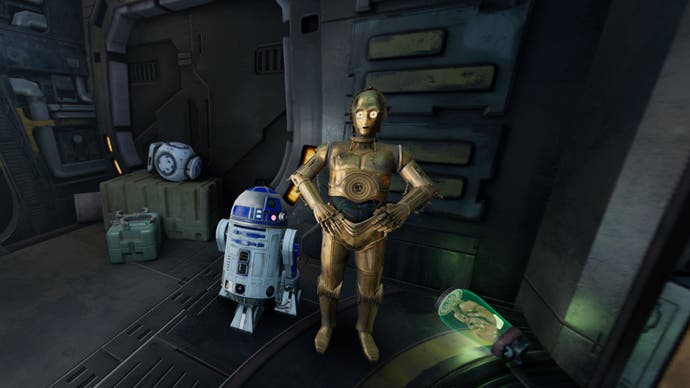
Star Wars: Tales from the Galaxy's Edge - Enhanced Edition
Star Wars: Tales from the Galaxy's Edge - Enhanced Edition does exactly what it says on the tin by enhancing and upgrading every inch of this PSVR2 port of the popular ILMxLAB developed Quest 2 game.
Released as one standalone game rather than in two parts like on the Quest 2, Star Wars: Tales from the Galaxy's Edge - Enhanced Edition certainly looked visually impressive to my eyes. I’ve never played the Quest 2 version but I reckon it’s safe to say it looks nowhere near as good as the port I tried on the PSVR2.
The demo I played started off in Seezlslak’s Cantina, a grimy bar situated right next to the Black Spire Outpost, which is a place that you may have visited in real life if you’ve ever been to Star Wars: Galaxy’s Edge in Disneyland, California. In fact, you can even see Black Spire Outpost if you look out of the cantina’s window and thanks to the eye tracking and foveated rendering in the headset everything out there, including the Millenium Falcon, looked as sharp and detailed as it might do if you were there in person.
In terms of gameplay, this portion of the game is rather sedate. Seezelslak feeds you quite a bit of exposition before you finally get to head out on an adventure, which for someone with an attention span as short as mine, can get a little aggravating. Thankfully there’s plenty of things to interact with in the cantina, including a drum kit, food you can eat and even a surprisingly addictive game of rocket darts.
Thanks to a combination of this interactivity, and the highly detailed visuals (I could even see the dirt under Seezlslack’s fingernails), it wasn’t too hard to get lost in the magic of the experience. Even though I was itching for some action at that point, I did appreciate the fact that the whole thing felt like a very authentic, and highly immersive, Star Wars experience that fans would love.
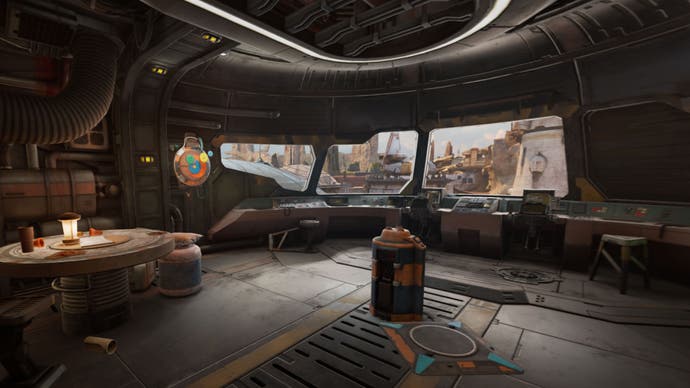
After spending some time in the Cantina I was eventually sent off to the planet Batuu where I was finally able to indulge in some good old-fashioned Star Wars blaster combat. The planet itself was nice and bright, with some lush green colours and some lovely detail to the distant panoramas but the simple and highly linear level design betrayed the games’ Quest 2 roots slightly.
Nevertheless, the combat was a lot of fun. Dual wielding a selection of Star Wars weapons was an absolute joy and each one felt slightly different to fire than the others thanks to the adaptive triggers and haptic feedback on the Sense controllers.
Overall Star Wars: Tales from the Galaxy's Edge - Enhanced Edition was probably the least technically impressive of the four games I played, but it was still a lot of fun and if it ends up being a PSVR2 launch title, it feels like it would be the perfect gateway for VR beginners to learn the ways of the Force (aka get their VR legs).
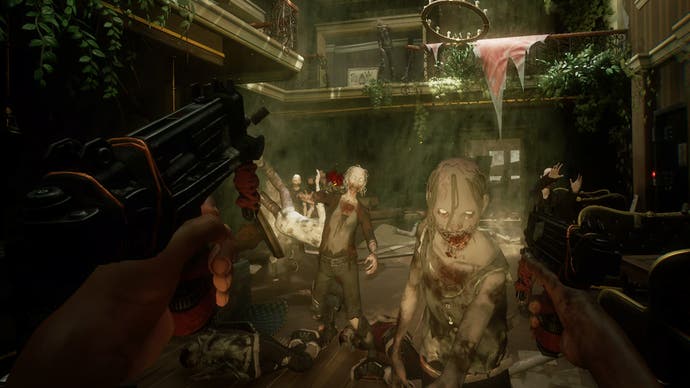
The Walking Dead: Saints & Sinners - Chapter 2: Retribution
The Walking Dead: Saints & Sinners was probably my favourite game on the PSVR so I was super excited to try out the sequel on PSVR2. The Walking Dead: Saints & Sinners - Chapter 2: Retribution (why does every PSVR2 game have a stupidly long title?) is an experience that will be instantly familiar to fans like me as the gameplay is pretty much identical to that of the original, just in a new setting with a fair amount of new tools and weapons to play with.
Thanks to the many dark areas of the game, this was a perfect title with which to test out the PSVR2's HDR which allowed me to see the detail in low lit situations much more clearly than I could in the first game. The 4K visuals also were a marked improvement on the PSVR original and much like every other game I played, there was no blurring of objects or muddy textures at a distance. Everything I looked at was as sharp and detailed as I'd have liked it.
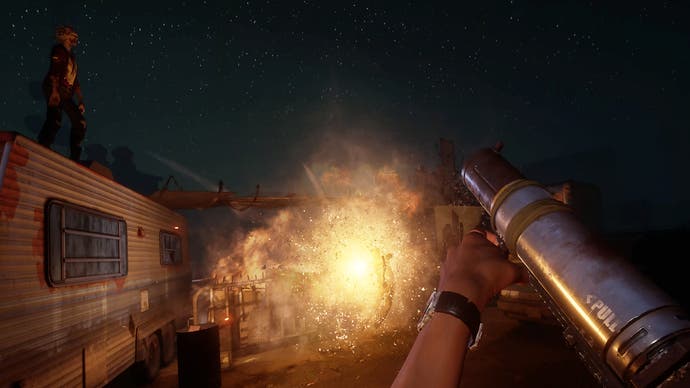
In terms of controls, the Sense controllers gave me so much more accuracy over the twin Moves that I had to use in the first game. The way Skydance Interactive gives virtual objects a feeling of weight and heft makes everything that you interact with feel real, but the complexity of that system often led to frustrations with the accuracy of the Move's motion controls. Not so here though, with the dual Sense controllers, I was able to perform fiddly little actions like switching the fire mode on an assault rifle or turning on a gun-mounted laser sight. These are things that would have been super aggravating to pull off with a Move, but with the Sense controllers I almost didn't even need to think about what I was doing - it just came naturally.
And of course, the new weapons were a lot of fun to play with too. Chief among them was the chainsaw, which was so gratuitously gory, I've had to cut the footage of it out of my video in order to please YouTube's moderation team. Revving the chainsaw up and slicing zombies in half was obviously a blast though, and with the haptics in the controllers, I could feel every gruesome cut like it was actually happening in front of me. Lush!
And that's probably more words about the PSVR2 than I've written about anything else this year combined. Phew! Hopefully you can tell that I was supremely impressed with the PSVR2 though. I was already excited for Sony's new headset but having experienced it for myself, I fully expect it to breathe a new lease of life into the slightly stagnating world of virtual reality gaming. It really is a huge step forward for PSVR in general, but as a simple to use, easy to wear piece of hardware, I can see it being a huge hit with VR fans new and old. "Early 2023" - which is still all we've got for a release date - can't come soon enough.
